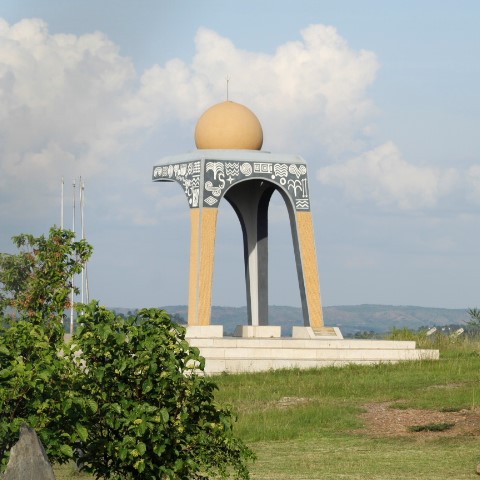1520AD Eclipse Monument on:
[Wikipedia]
[Google]
[Amazon]
The Biharwe Eclipse Monument aka 1520AD Biharwe Eclipse Monument is a monument that was built in commemoration of the total eclipse of the sun which took place on April 17, 1520. It is located in Biharwe town in Mbarara District, 
Text engraved on the stone at the Biharwe eclipse monument
{{coord, -0.525973, 30.739608, format=dms, type:landmark_region:UG, display=title Monuments and memorials in Uganda
Uganda
Uganda, officially the Republic of Uganda, is a landlocked country in East Africa. It is bordered to the east by Kenya, to the north by South Sudan, to the west by the Democratic Republic of the Congo, to the south-west by Rwanda, and to the ...
.

History
The monument was unveiled by theYoweri Kaguta Museveni
Yoweri Kaguta Museveni Tibuhaburwa (born 15 September 1944) is a Ugandan politician and military officer who is the ninth and current president of Uganda since 1986. As of 2025, he is the third- longest consecutively serving current non-royal n ...
on 30 August 2014. It is the only scientifically dated event in the early history of the Great Lakes Region. The eclipse is mentioned in the folktales of Bunyoro
Bunyoro, also called Bunyoro-Kitara, is a traditional Bantu kingdom in Western Uganda. It was one of the most powerful kingdoms in Central and East Africa from the 16th century to the 19th century. It is ruled by the King ('' Omukama'') of ...
, Buganda
Buganda is a Bantu peoples, Bantu kingdom within Uganda. The kingdom of the Baganda, Baganda people, Buganda is the largest of the List of current non-sovereign African monarchs, traditional kingdoms in present-day East Africa, consisting of Ug ...
, and Ankole
Ankole was a traditional Bantu peoples, Bantu kingdom in Uganda and lasted from the 15th century until 1967. The kingdom was located in south-western Uganda, east of Lake Edward.
Geography
The kingdom of Ankole is located in the South-Western ...
; this helped historians to know the royal ancestors of those kingdoms.
On his way back to his kingdom in Bunyoro, when the eclipse occurred, the King of Bunyoro, Olimi I Rwitamahanga, was forced to abandon all his loot, which included cows, women, and slaves that he had looted from Rwanda during the reign of Umwami Ruganzu II Ndori. The loot that was left behind was inherited by Ntare I Nyabugarobwera, who was the king of Nkore at that time. The cows were named "Empenda ya Munoni" and "Enduga Mwiguru", which are translated as "cows from heaven".
Some legends have it that because he could not go back to his kingdom empty handed, Olimi I Rwitamahanga (the king of Bunyoro) chose to invade Buganda kingdom under the reign of Ssekabaka Nakibinge. During the battle in Bulemezi, Ssekabaka Nakibinge and his commander Kibuuka were killed after Kibuuka's Munyoro concubine betrayed him. Nakibinge was succeeded by his son Mulondo.
The Biharwe monument was constructed with the help of a grant from UNDP
The United Nations Development Programme (UNDP) is a United Nations agency tasked with helping countries eliminate poverty and achieve sustainable economic growth and human development. The UNDP emphasizes on developing local capacity towar ...
that was given to Igongo Cultural Centre and Country hotel under the Business Enterprise Innovation Challenge in December 2019.
Joseph Sematimba, a creative director and lecturer of art and design at Makerere University
Makerere University (; Mak) is Uganda's largest and oldest institution of higher learning, first established as a technical school in 1922, and the oldest currently active university in East Africa. It became an independent national university in ...
in Kampala
Kampala (, ) is the Capital city, capital and largest city of Uganda. The city proper has a population of 1,875,834 (2024) and is divided into the five political divisions of Kampala Central Division, Kampala, Kawempe Division, Kawempe, Makindy ...
, designed the Biharwe Eclipse Monument.
The three pillars
The three pillars on the monument represent the three kings (Olimi, Ntare, and Nakibinge) who were affected directly by the Biharwe eclipse. The fourth pillar was not added, as this symbolised the instability amongst the kingdoms that is the cattle raids, famine, and tribal wars of that era.The globe / Sphere
The sphere represents the moon that is uniformly offset along a circular void on top to create a ring void that surrounds the base of the globe. The gap was designed to simulate the eclipse with its shadow on the ground as long as there is sunshine. The simulation is a transforming shadow that is cast at the base of the monument that keeps evolving from a crest shape shadow in the morning sunrise to a ring-shape shadow at mid-day and finally to a fading crest shadow at sunset.The pictorials and symbols on the surface
The pictorials include drums, shields, spears, and other symbols that represent aspects of different cultures such as community values, lifestyles, beliefs, and tools that were used for different purposes. They are derived from the patterns that were used on the traditional Hima huts.See also
*Bunyoro
Bunyoro, also called Bunyoro-Kitara, is a traditional Bantu kingdom in Western Uganda. It was one of the most powerful kingdoms in Central and East Africa from the 16th century to the 19th century. It is ruled by the King ('' Omukama'') of ...
* Julia Kibubura
References
External links
Text engraved on the stone at the Biharwe eclipse monument
{{coord, -0.525973, 30.739608, format=dms, type:landmark_region:UG, display=title Monuments and memorials in Uganda